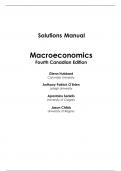Exam (elaborations)
Solutions Manual For Macroeconomics 4th Canadian Edition by Glenn Hubbard, Patrick O'Brien, Jason Childs
- Course
- Business Statistics
- Institution
- Business Statistics
Solutions Manual Macroeconomics 4th Canadian Edition by Glenn Hubbard, Patrick O'Brien, Jason Childs ISBN: 9780137688319. Macroeconomics, Canadian Edition, 4th edition solutions.; TOC-=1.Economics: Foundations and Models 2.Trade-offs, Comparative Advantage and the Market System 3.Where Prices Come...
[Show more]



